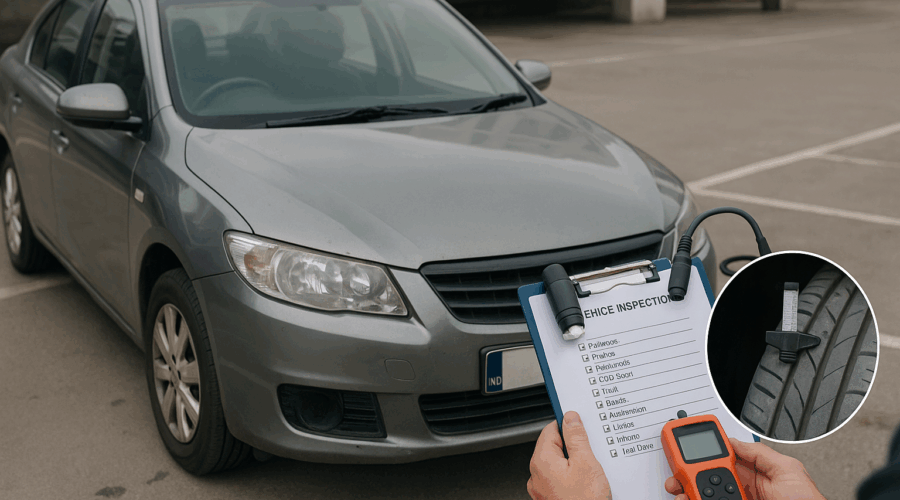How to Inspect a Used Car Before Purchase
-
Inspect in daylight after a cold start.
-
Check body, paint, tyres, suspension, leaks, and underbody.
-
Scan electronics and do a proper test drive (city + highway).
-
Verify the paperwork: RC, insurance, service history, PUC, challans, and loan NOC.
-
Don’t pay until the seller provides clean docs and you’ve signed a sale agreement.
1) Pre-meet prep
-
Ask for VIN/registration to pull basic history and insurance status.
-
Request service records, previous accidents/repairs, and any modifications.
-
Confirm the car isn’t under hypothecation (or ask for loan closure + NOC).
2) Exterior checks
-
Panel gaps & paint: Uneven gaps or mismatched paint shades can signal repairs.
-
Rust & sealant: Check door sills, wheel arches, boot floor, and underbody.
-
Glass & lights: Look for cracks, fogging, or non-OEM headlamp units.
-
Tyres: Even wear? Tread depth ≥ 2–3 mm. Uneven wear can mean alignment/suspension issues.
3) Interior & electronics
-
Odours & moisture: Musty smell = possible leak/flood damage.
-
Dashboard cluster: All warning lights should illuminate at ignition and then go off.
-
Infotainment & HVAC: Test Bluetooth, CarPlay/Android Auto, AC cooling (idling and while driving).
-
Windows, mirrors, locks, horn, wipers, washer: Test everything.
-
Airbags: Confirm airbag indicator cycle; inspect steering/trim for signs of deployment or tampering.
4) Engine bay (cold start)
-
Fluids: Engine oil (colour/level), coolant, brake fluid—no sludge or milky residue.
-
Leaks: Look under the car after a few minutes of idling.
-
Belts & hoses: No cracks or fraying.
-
Idle behaviour: Stable RPM, no hunting or knocking.
5) Underbody & suspension
-
Use a flashlight: look for leaks, fresh underbody paint (could hide rust), bent members.
-
Push down on each corner—excessive bounce = weak shocks.
-
Listen for clunks over speed breakers.
6) Test drive checklist
-
Start, idle, acceleration: Smooth power delivery; no jerks or hesitation.
-
Transmission: Manual—no crunching, clutch bite mid-travel; Automatic—no shudder, smooth shifts.
-
Steering & tracking: Car should track straight; no pull or vibration at 80–100 km/h.
-
Braking: Straight stop, no steering shake, ABS kicks in evenly.
-
AC performance while driving: Should stay cold without engine strain.
-
Noises: Whines (gearbox), humming (wheel bearing), thuds (suspension), squeals (belts).
7) OBD scan (recommended)
-
A simple OBD-II scan can reveal stored/hidden error codes (misfires, emissions, ABS, airbag faults).
8) Paperwork to verify (India)
-
RC (Registration Certificate): Matches VIN/engine number, correct owner details.
-
Insurance: Active? Check claim history if possible; comprehensive preferred.
-
PUC: Valid.
-
Service history: Stamps or invoices from authorised/service centres.
-
Challans: Clear pending e-challans online.
-
Hypothecation: If loan closed, get Form 35 + bank NOC to remove HP from RC.
-
NOC for inter-state transfers (if applicable).
-
Emission & fitness (for older/commercial vehicles).
9) Price & negotiation
-
Compare similar models’ asking prices by year, variant, km, and condition.
-
Deduct for immediate expenses: tyres, battery, brake pads, clutch, insurance renewal, overdue servicing.
10) Sale agreement & transfer
-
Use a written Sale Agreement (as-is condition, odometer reading, token/advance terms).
-
Complete Form 29/30 at RTO (or state equivalent), handover keys only on full payment, and submit a delivery note.
-
Update insurance to your name immediately after sale.
Pro tip: If anything feels off, walk away. There will always be another car.



